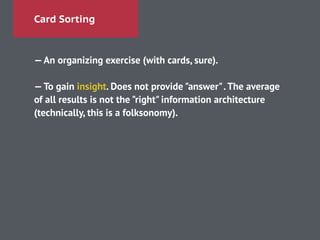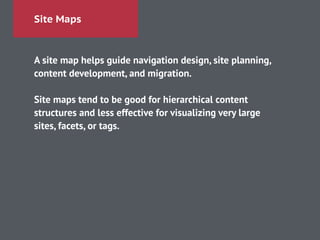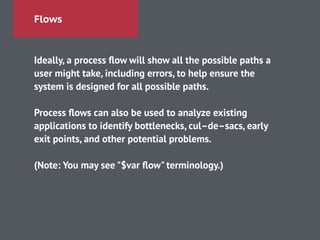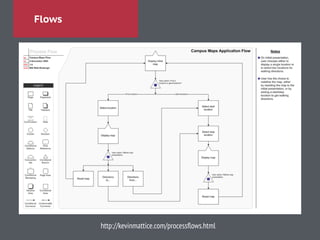Module 06: Maps and Flows
- 1. Sorting, Maps, Flows We’ve done user research. ! We collected observations and information. ! We may have found some insight (though we always welcome more). ! Now we start to organize it.
- 2. Sorting, Maps, Flows Any engineers? Mapmakers? Did you come here from far away? ! Tell us how you got here. ! Tell us how programming logic works. ! How does one reach one’s goal?
- 3. Card Sorting
- 4. Card Sorting —An organizing exercise (with cards, sure). ! —To gain insight. Does not provide "answer".The average of all results is not the "right" information architecture (technically, this is a folksonomy). !
- 5. Card Sorting —Two types: open and closed ! — Open: Piles/groups emerge as participants place cards down ! — Closed: Grouped according to given categories
- 6. Card Sorting How to explain a card sort ! —"These are all topics that will appear on a site." ! —"Please group things you’d expect to find together." ! —"It’s okay to make subgroups if that seems like the right thing to do." !
- 7. Card Sorting Let’s take a few minutes. What have we learned from our research that we could organize? What visitors need to know? Want to do?
- 8. Site Maps
- 9. Site Maps A site map shows the overall structure and relationships between items on a website. ! For large sites a site map may document patterns of organization, instead of accounting for every single page. !
- 10. Site Maps A site map helps guide navigation design, site planning, content development, and migration. ! Site maps tend to be good for hierarchical content structures and less effective for visualizing very large sites, facets, or tags.
- 11. Flows
- 12. Flows A flow documents how a user moves through an application or website ! Including the different states or branches the user might access. !
- 13. Flows Ideally, a process flow will show all the possible paths a user might take, including errors, to help ensure the system is designed for all possible paths. ! Process flows can also be used to analyze existing applications to identify bottlenecks, cul–de–sacs, early exit points, and other potential problems. ! (Note: You may see "$var flow" terminology.)
- 14. Flows Card sorting: the dots ! Flows: the lines connecting the dots
- 15. Flows It’s important to understand exactly how, step by step, users can go through the site and how to get users back on track if they’ve deviated. ! This is true for both implementers and designers.
- 18. Flows
- 19. Flows Do we have any known actions our users might want or need to take? Any critical information they’ll need to find? Let’s sketch out some flows.
- 20. Flows Any insights? (Remember to take photos of your work!)





















